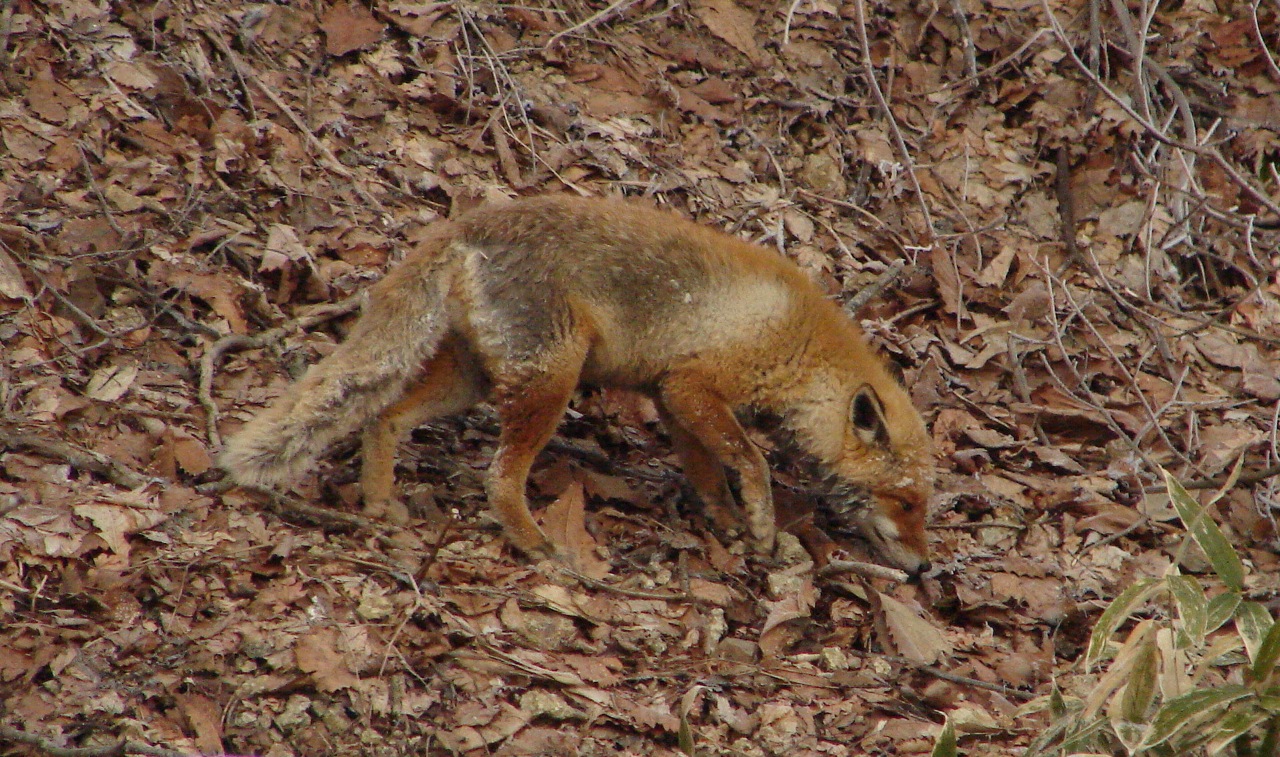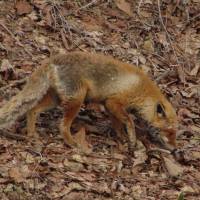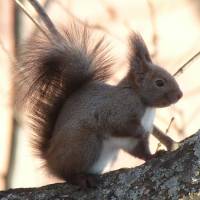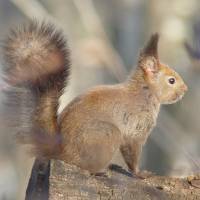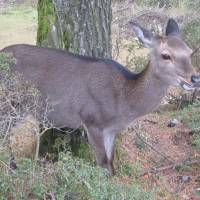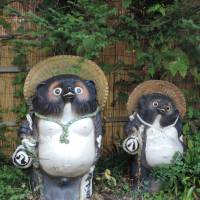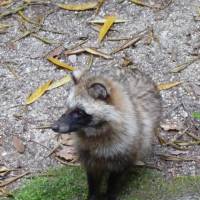My thoughts were miles away as I crossed the parking lot outside my Hokkaido home. Then a nagging doubt intruded: Had there — or had there not — just been a formless blur of movement on the ground beyond my car? I had certainly not seen anything, so if there had been something, then my awareness of it had been merely subliminal.
Imagine my shock, then, when I pulled out of the parking area a few minutes later and saw a Red Squirrel running down the road ahead of me, then jinking right and disappearing into a narrow, treeless garden.
It was as if I'd broken a dream: The squirrel was exactly the same size and color of my blurred, subliminal imagining. I'll trust my instincts next time.
Even in 2,000-hectare Nopporo Forest, which I like to think of as "my garden," only occasionally do I see squirrels, and that woodland is a good 10 minutes away by car. I can't imagine how long it would take a squirrel to cover that distance — or how many cars the one I'd seen may have had to dodge in the alien semi-urban landscape that separates my parking lot from the forest.
The squirrel's instincts may have been driving it to disperse from its natal territory, but those same instincts were likely to see it lost in suburbia and at increasing risk of becoming roadkill.
That brief sighting led me to reflect on the luck you need to have when setting out to watch mammals. Birds are easy; they're almost always in view and in just about every habitat. Plants are even easier; they don't even try to flee. Mammals, though — well, when you consider that most have good eyesight and a good sense of smell, and they've learned to avoid humans, with many also nocturnal, it's surprising we ever encounter them at all.
The easiest way to watch mammals, if you don't have endless hours to spend wandering in Japan's mountain forests, is to visit areas they habitually frequent and where chances of sightings are good. A few of these straightaway spring to mind, such as Jigokudani Yaen-koen (Hell Valley Monkey Park) 850 meters up in the Yokoyu River valley of northern Nagano Prefecture, where Japanese Macaques can be watched year round, and Hakusan National Park straddling Fukui, Gifu, Ishikawa and Toyama prefectures in western Honshu, where an hour or so spent in the Mount Bunao Observation House scanning the slopes across the valley is likely to yield a sighting of one of the goat-antelopes known as Japanese Serow — with perhaps a Golden Eagle flying overhead for good measure.
Meanwhile, during winter in eastern Hokkaido, Red Foxes become partly diurnal and seeing several in a day is not unusual, and as for Sika (Japanese Deer), well, they now seem to be everywhere there.
In addition, there are whale-watching operations around Japan generally giving good chances of seeing a wide range of cetaceans, from the largest toothed whale (Sperm Whale) to small Harbour Porpoises, with baleen whales such as Humpbacked, and dolphins and porpoises in between.
But where to go to find the mammals of central Honshu?
I am always on the lookout for lodges, pensions and minshuku (B&Bs) boasting wildlife in their gardens or very close by (so if you know of any do let me know!).
Consequently, just a few weeks ago I was tempted to ply a circuit through the mountains of central Honshu to check out three places that, from their advertising at least, seemed very promising.
The first, in Oku-Nikko, western Tochigi Prefecture, even sported photographs on its website of Japanese Badger, Red Fox, Japanese Marten and Palm Civet — and they took my booking with tantalizing promises of sightings. Sadly, though, I soon realized that no-one working there knew anything about the local wildlife — other than to say "things occasionally run through the garden." So, resorting to good old trusty Plan B, I set off along a nearby forest trail with a flashlight.
Within minutes I picked up green eye-shine, and soon heard the alarm whistles of Japanese Deer. In fact, they seemed to be everywhere I looked, but despite logging more than 75 in two forays that evening, I saw no sign at all of the mammals I had hoped for. Not only had Japanese Badger and Japanese Marten eluded me, but the accommodation wasn't quite the style it promised either. So, undeterred, I set off for the next spot with my hopes still high.
Winding through the mountains of Tochigi Prefecture to Gunma Prefecture, I was struck once more by how quickly the character of the forest in Honshu can change. Around Oku-Nikko, it had me believing I was in part of Hokkaido — with rugged-barked birches mixed with spruce and fir giving a wonderfully diverse texture and contrast to the autumnal scene.
Then, heading westward over the watershed, and at slightly lower altitude, I was suddenly in rich deciduous forest with dozens of tree species contributing to a light airy woodland unlike any I ever encounter in my northern home island of Hokkaido.
Meanwhile, further on I was to encounter pines, and then an increasing number of broadleaved evergreens were added to the mix, many of them rhododendrons. There was wonderful diversity in the plant life and, what is more, none of it was avoiding me!
My second trial was at a marvelous mountain lodge in the Gumna Prefecture resort of Dogenso beside the rushing waters of the Tone River. Full of character and charm, it was a welcoming and appealing place, and the plethora of ceramic art outside and the illustrations inside all promised one creature I was keen not just to see but to watch: Tanuki, a species often wrongly described as a badger, though there is actually a true Japanese Badger. Though pottery Tanuki are traditionally placed outside drinking establishments, and fleeting glimpses of real ones are not uncommon, being able to watch them is a rare treat.
In fact, only once have I been able to observe them for any length of time, and here, at Dogenso, I believed I was in with a very good chance of spending an evening watching them. I took up position early in the observation room overlooking the feeding station ready to spend the entire evening watching, but alas not a single Tanuki revealed itself between darkness and midnight. The only consolation was a trio of Red Fox, which came repeatedly and almost continuously, providing alternative entertainment, but in a form I can easily appreciate closer to home in Hokkaido.
With spirits not quite so high any more, I moved on to my third and final trial. That was a lodge in Nagano Prefecture that has build its reputation on its resident musasabi — Japanese Giant Flying Squirrels.
As I was to discover, though, here as well reality and advertising were out of sync and even the famous nest boxes they claimed to have housing wild squirrels were in disrepair and obviously long unused. After wandering the local woods unsuccessfully I decided it was high time to accept defeat and soak away my disappointment in the lodge's pleasant-looking outdoor hot spa.
I settled in, up to my neck in soothing, contemplative warmth, and my thoughts were again soon miles away. Just then a will-o'-the-wisp suddenly morphed into reality as a Giant Flying Squirrel appeared, quite literally on the trunk of the dead tree that I'd been staring at! I watched it sit on a branch for a while before it scurried up the main trunk and launched itself from the top — gliding away across the river gorge toward the darkness of trees on the far side.
Stunned by that fluke view, I stared unfocused into the distance, lost in recall of that and other precious moments. Then, on the far side of the river, trotting along the dimly lit woodland trail toward a little temple, I realized I was watching a Tanuki!
Talk about snatching victory from the jaws of defeat; my chance mammal sightings were nothing like what I had hoped for, but they were another reminder — just like the squirrel in my parking lot — that mammal-watching is all about reveling in the rare opportunities offered.
Mark Brazil, who has written Wild Watch for more than 30 years, also organizes and leads wildlife, birding and photographic excursions around Japan, and is the founder of Japan Nature Guides. His latest book, a collection of essays titled "The Nature of Japan," is just out and is available from www.japannatureguides.com.



